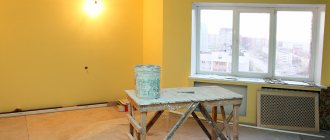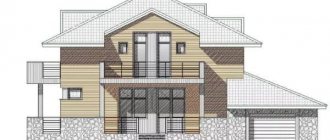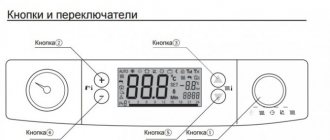In the fall you built a house. It will remain cold until the warmth of next year. Is this dangerous for the home and its contents? What if the house is periodically heated?
Dmitry Belkin
Author: Dmitry Belkin
In this article I would like to consider an issue that worries many people. The question is next. What could happen to my home, furniture and decoration if I leave the house for the winter and do not heat it? What will happen if I occasionally come to my house and heat it?
These are difficult questions. They are complex not because the physics of the phenomena is complex, but because the variety of our materials, decoration, furniture and everything that is in our homes is too great. So we will consider the questions posed using examples. But first, let's consider the physics of the phenomenon.
What happens in the house in winter if it is not heated?
In winter, the air temperature in our house drops. What is characteristic of cold air? The fact that the amount of moisture in it decreases. It decreases, and significantly! Dozens of times. What happens to the moisture that was in the air while it was warm? Well, she definitely needs to go somewhere! It usually falls out of the air and settles on surrounding surfaces in the form of frost. The frost, by the way, also dries up over time and dryness reigns in our house.
What happens to the body in the cold? It's drying. I remember as a child... I grew up with my grandmother. Grandma was terribly businesslike. This is what I remember now. The whole family depended on her. Moreover, she managed the family according to Domostroi and was the clear head. My parents were hiding from this Domostroy each at their own work, and I had nowhere to hide, so I was exclusively with my granny and I owe my meticulous character, perseverance and determination solely to her. I also inherited from her a fundamental love for Domostroy, but this is not the subject of the article and I am not going to talk about it. Do not worry.
So what am I talking about? Oh yes! Grandmother washed clothes in winter and dried them in the cold. And I kept asking, “Does the laundry dry in the cold? “The grandmother answered that it dries, and very well, and the stronger the frost, the better it dries. I didn’t understand this then, but I believed it, because, as I already said, my grandmother was our leader, and her authority was very great. Now that I myself am already a grandfather (in appearance, not in status) I understand that grandma was right. Things dry out in the cold. The walls are drying, the trim is drying, the furniture is drying. Everything that contained moisture gets rid of this moisture. What happens to a thing when moisture is removed from it? It shrinks a little in size. People say that such a thing has dried up.
Log house completely without heating
Since not everyone who has one visits a dacha in winter, the most logical option seems to be a complete refusal of heating. It should be said that this method of operation is not the worst. However, when we talk about completely abandoning heating, we mean that even household heaters cannot be used. This leads to the main disadvantage of this mode.
It lies in the fact that any visit to the dacha during the cold season will be accompanied by the inability to spend time comfortably in the house. You will have to completely forget about spending the night. And in general, any life activity in an unheated house in winter means an increase in humidity in it. Any owner of a wooden home is probably aware of how moisture affects wood. It condenses on surfaces and penetrates the wood, making it a breeding ground for microorganisms - fungus and mold.
But since this method is not the worst, it means there are advantages. The first is zero heating costs. The second advantage is this. If a wooden house is not heated at all, then the temperature inside it will always be balanced with the outside temperature. It follows that the risk of condensation forming indoors will be minimal. That is, the house will not rot at an accelerated pace from the inside.
What happens when we arrive at an unheated house and turn on the heating?
The air becomes warmer and can already hold tens of times more moisture. If it can, it means it can accommodate it. First of all, the frost melts and goes into the air. But here's an ambush! Furniture, walls and all other objects heat up more slowly and remain cold. This means that they will be wet, because they cool the air around them and moisture falls out of it again. Only in the form of dew, not frost. In fact, it turns out that frost melts on things and they become wet. When will things become dry? When they are heated to a temperature that will allow them to dry. Not earlier. Moreover, some of the moisture will go into the air, and some will be absorbed into things, be it furniture or a wall. It is clear that different materials absorb differently. Breathable materials are highly absorbent. Non-breathing - weak. Plastic does not absorb moisture at all, so it can only dry out. The same applies to wood coated with oil paint or varnish.
Heating with minimum temperature support
To organize this mode of operation in a country house, you will need a full-fledged heating system. Powered by natural gas or electricity. Moreover, the heating boiler must not just be automatic. It is desirable that it “be able” to adjust its power based on the air temperature in the premises. After all, it will change throughout the winter along with the weather outside.
The minimum temperature in question depends on where the dew point is located in a log house. If we talk about walls, the thicker and better insulated they are, the lower the temperature will have to be maintained. As a rule, wooden country houses are built from the cheapest 100 mm timber. Without additional insulation, in such a dacha it is necessary to maintain the temperature in the premises at least at 10-12 degrees.
This heating method has only one drawback - heating costs cannot be called low.
But the benefits here are a jackpot. Firstly, when you periodically visit the dacha, there will be no beater inside it. Secondly, it will not take as much time to warm up the premises to a comfortable temperature than when the temperature in the house is sub-zero. Thirdly, and this is the most important thing for a timber house - condensation will not accumulate in the premises. This means that in spring there will be no fungus, mold or unpleasant odor. The service life of the log house will also increase significantly.
How and why does furniture dry out?
Dry railings
Now we can roughly understand why furniture is drying out. Furniture dries out because moisture comes out of it. Evaporates. The components that make up the furniture shrink, dry out, and gaps may form between the pieces. Notice! In order for a thing to dry out, it only needs to freeze and stay in a cold house for a while. Whether you heat your house periodically or not is the second question.
But why does furniture dry out? Because it is made poorly. For example, it is made of wood, which expands very significantly when wet and shrinks just as significantly when dry. Or maybe the furniture is not painted or varnished? Then it will absorb well and dry well and dry out. I had a cute wooden flower stand. It was made in an antique style and was decorated to look like mahogany. Time passed, the varnish evaporated somewhere, and after many years of faithful service the thing dried out completely. On the one hand, it’s a pity, but on the other, it’s his own fault. It was necessary to update the varnish.
When furniture is made with high quality, the boards are carefully selected according to their pattern and structure. A strict selection of materials is used to check for knots and other defects, high-density wood, high-quality adhesives, varnishes and paints are used, and so on and so forth. Such furniture does not dry out. But it also costs a lot of money. This also seems understandable.
Periodic heating of a timber house
Unfortunately, this mode of operation is most common among summer residents. We arrived on the weekend, turned on some oil, infrared or fan heater, warmed up and left. At first glance, this approach seems optimal - heating costs are low, and the house “smells” of warmth.
However, it is precisely this mode of operation of a log house in the cold season that is the most harmful of all possible. The problem is this. When you come to your dacha on weekends or holidays, the temperature inside the house is the same as outside. Plus or minus a few degrees. When you heat a room locally, a temperature imbalance occurs. As a result, when you turn off the heater and leave, condensation will begin to form in the house. And due to the fact that you breathed there, cooked or simply heated food, the humidity rises even more.
As a result of such exploitation, in the spring you can find mold, mildew and a characteristic persistent smell of dampness in a log house.
Protection from rodents during your absence
Whether your home is heated or unheated, mice and rats can enter your home. To avoid attracting undue attention from these pests, place all food supplies out of their reach. It should be taken into account that, having smelled something edible, for example, cereal, rats are able to gnaw even through a cabinet door. And having finished with food supplies, wires, wallpaper, bed linen and everything that can be chewed will be used. You should not use special poison, as it can later harm your pets or you. It’s better to clean up the mess and install an electronic repeller.
Method 6 - electrode boiler
Inside the electrode boiler there are electrodes, which act as a heating element. When current passes through a liquid, heat is generated. This means that in electrode boilers there is no actual heating element on which scale could form. The absence of scale will greatly facilitate operation.
Electrode boilers are highly reliable and operate much longer than tubular heaters. In addition, they are small in size, which is very convenient for a small residential building. The disadvantages include high requirements for the liquid used as a coolant. Water must undergo special treatment. Often, antifreeze generally must be exclusive - from the device developer.
The photo shows an electrode boiler Galan, Russia
Heat loss through walls
Heat loss through the walls - all owners immediately think about this. They calculate the thermal resistance of the enclosing structures, insulate them until the standard value R is reached, and then finish their work on insulating the house. Of course, heat loss through the walls of the house must be taken into account - the walls have the largest area of all enclosing structures of the house. But they are not the only way for heat to escape.
In order to limit heat loss through the walls, it is enough to insulate the house with 150 mm of highly efficient insulation for the European part of Russia or 200-250 mm of the same insulation for Siberia and the northern regions. And with that, you can leave this indicator alone and move on to others that are no less important.
Electric boiler
Unlike a gas system, an electric boiler is compact and easy to operate. There are different models of electric boilers. The power of the unit is selected depending on the area of the room. Electricity heats the air, then a pump pumps it throughout the heating system. Heated air constantly circulates in a confined space, heating the house.
If you place the boiler in the basement, it does not take up space in the house, but this is fraught with large heat losses. A lot of heat will be spent heating the basement. When planning a house, it is better to allocate a separate room for the boiler, adjacent to the residential sector. Thus, you will ensure high heat transfer with minimal heat loss and save electricity.
Electric boilers operate silently, do not emit any odor, and are easy to install and operate. The specifics of their connection should be taken into account. For example, if your boiler is low-power (3.5-7 kW), it needs to be allocated a separate branch from the distribution panel and installed automatic protection. A powerful unit (from 7 kW and more) is connected only to a three-phase network.
The only disadvantage of an electric heating system is its high price, but people often use it because of its convenience and ease of installation.
Calculation of heating a room with an electric heater
So, let's try to translate everything said above into some practical plane. That is, we will try to calculate how much energy is required to replenish heat losses, and how much is required to warm up the volume of air in the room. Moreover, we will calculate heat losses not according to a simplified scheme, but according to an expanded one, taking into account polynomial factors that influence their quantity.
Next, let’s compare the total heat demand with the capability (power) of the existing electric heater - then it will be possible to draw certain conclusions.
Don't be afraid, counting won't tire you - no formulas, just a special online calculator. And all the necessary tabular values and formulas have already been entered into it.
Calculator for calculating the “accounting” of heating a room with an electric heater
Go to calculations
Universal boilers
They are used if you need to heat your dacha in winter without gas. A universal boiler becomes a “savior” when there are constant power outages on the site. Sometimes it is not possible to regularly buy coal for solid fuel units, and a universal system is the only way out. It can operate on the following types of fuel:
- liquefied gas;
- liquid substances;
- coal;
- firewood
The system works by heating the coolant. The boiler is equipped with several burners designed for different types of fuel. It is controlled automatically and is equipped with overheating protection, and its operation is safe for the user. To use different types of fuel, the system provides for changing settings. It regulates the operating mode of the boiler, and it always produces optimal efficiency.
Some tips on how to keep warm
If the house has heating radiators, cover the walls behind the radiator with reflective foil. The heat will not warm the wall, but will be reflected from the foil and will heat the room.
If you use gas for heating, be sure to install a gas meter. You will be able to control gas consumption.
We heat the house with wood
Many are looking for an alternative to gas heating. But is it possible to heat a modern house with wood? We are, of course, not talking about the traditional Russian stove on which our grandmothers cooked. Now there are cast iron and steel stoves that can be heated with coal or wood. Outwardly, they resemble the well-known potbelly stove, but have a number of advantages. Let us immediately note that the cast iron construction is more reliable.
Sellers of wood stoves claim that they can heat the entire house and that such heating will be cheaper than gas heating. Can you believe this? In order for such a stove to operate at full capacity, special wood is needed. You will need perfectly dry logs. It is also better to purchase only hard wood. Pine or maple logs will not work. You will have to buy oak or beech wood. Other wood will also burn in this stove, but the heat from their combustion will be much less.
Minuses
Now let's analyze the disadvantages of such heating. The stove will have to be installed in one room, which will heat up as much as possible. Less heat will flow into other rooms. When heating with gas, you distribute the body evenly in all rooms.
By turning on a double-circuit electric boiler, you can not only warm up the house. You will have hot water in the bathroom and kitchen. But you can’t connect wooden heating to a shower stall.
Firewood will have to be stocked and stored in a separate room. To maintain a pleasant temperature in the house, you will have to add firewood several times a day. The ash also needs to be raked out and taken outside.
Now about smoke and combustion products. Ventilation must be provided for them. Otherwise, there will be a threat to health or even life. The stove cannot be left unattended, otherwise a fire may occur if a spark falls on the floor or clothing catches fire from the hot surface.
You can purchase a boiler that runs on compressed sawdust. This stove is expensive, but has several advantages:
- fuel can be added once every 3 days;
- little ash is generated, it can be removed after a week or two;
- the heat transfer of this design is at the level of a wood stove;
- Sawdust cylinders are very light and take up little space.
Candle based heater
Sometimes there is a need to heat only one room or workplace. We can recommend purchasing a Doyle Doss thermal device. The American called his invention “Heat Trap”. The heat source is a burning candle. It turns out that when a candle burns, a lot of heat is generated, but it dissipates.
The heating device allows you to capture heated air. A special ceramic cap is located above the flame. Its task is to collect and accumulate warm air. The heat warms the ceramic cap, which warms the room.
This is what a Dosa heater looks like.
You certainly shouldn’t expect that such a heater will solve the heating problem. Experience has shown that a ceramic radiator can warm up a small room in no earlier than 10 hours. If the house is connected to electricity, it is better to use an oil radiator.
If you need to heat a separate room or a small area of the room, it is better to buy an infrared heater. It starts working immediately and does not consume much electricity.
Previously, many were afraid that this type of radiation could have a bad effect on health. It turned out that infrared rays even have a healing effect. This type of radiation is used to prevent colds.
Brick ovens
The main “heating unit” of a brick stove is the wood-burning firebox. Oxygen is constantly supplied to it so that the flame is at the desired level. The stove is equipped with a chimney that removes waste combustion products to the outside. If you follow these rules and regularly clean the chimney, the stove will always provide warmth to the residents of the house.
The ash pan (or blower door) provides air flow. The masonry laid inside the furnace ensures that combustion products escape outside. There are different stove designs. To heat the cottage, use one of four:
- “Dutch”;
- fireplace;
- “Swedish”;
- Russian.
The brick oven is compact. You can give it any design with your own hands, in accordance with the interior of your house or cottage. It is fireproof, and natural materials (stone, brick) are used in its production. However, building a stove requires serious skills, without which it will not be possible to create a full-fledged heating system. Making masonry is a long and labor-intensive process that requires time and skill. The cost of natural materials is high, but if you are the owner of a real stove, it will serve you for a long time. In addition, the stove does not depend on gas and electrical communications. If you have firewood and know how to heat it, it will warm a person in any cold weather.
Heat loss through the ceiling
All the heat goes up. And there it strives to go outside, that is, to leave the room. Heat loss through the ceiling in your home is one of the largest quantities that characterizes the loss of heat to the street.
The thickness of the insulation on the ceiling should be 2 times the thickness of the insulation in the walls. If you mount 200 mm in the walls, mount 400 mm on the ceiling. In this case, you will be guaranteed maximum thermal resistance of your thermal circuit.
What are we doing? Walls 200 mm, floor 300 mm, ceiling 400 mm. Consider that you will save on any energy carrier that you use to heat your home.
Preparing the heating system for the winter season
- Before preserving the house, all water from the heating system is drained. This option does not require material costs, but at the beginning of the next season it is necessary to fill the water back, which can only be done at above-zero temperatures, and there is a danger of air locks.
- Antifreeze is poured into the heating system, which can withstand temperatures down to thirty degrees. This procedure is enough to be done once, and during operation all that remains is to monitor the wear of the equipment and the appearance of leaks.
Heat periodically
At first glance, this option seems the most reasonable. Especially in terms of comfort and heating costs. Even though a house that has cooled down in a week is still not easy to warm up to a more or less comfortable temperature. However, most people do just that, making a serious mistake.
The fact is that a wooden log house suffers from such exploitation. The condensation process is to blame for this. Moisture that entered the premises from the lungs, as well as evaporated under the influence of sudden heat, will condense and settle on surfaces in the house after the heating is turned off. But the tree “doesn’t like this.”
In fact, this option is the worst from the point of view of the resource of a timber country house. Mold, mildew, dampness and accelerated rotting are guaranteed.
Solid fuel systems and their applications
Due to the high cost of electricity, people install solid fuel heating systems. They are similar to metal stoves, but their design is different. They use the following as fuel:
- wood waste;
- peat bog;
- briquettes with coal.
The solid fuel boiler is also connected to the pipes of the general heating system. It is reliable, easy to operate and “omnivorous”, because you can put all types of solid fuel in it. Combustible products need to be purchased with a reserve so that they do not run out suddenly. The efficiency of the unit is low, and its chamber must be cleaned regularly at the end of the combustion cycle. This inconvenience is compensated by the ease of use and “unpretentiousness” of the universal unit and its components.
The solid fuel boiler does not depend on other communications and operates for a long time after a single load. This ensures economical consumption of coal or coke. If you load it with firewood or wood waste, it works continuously for 48 hours, without the need to add fuel again.
On a note! When using coal briquettes or coal, the boiler supplies the house with heat for 5 days without interruption.
Liquid fuel boilers for heating
A steel or cast iron boiler is connected to a water heating system. The following is used as fuel for such boilers:
- diesel;
- kerosene;
- processed oils;
- fuel oil.
To install the system, you also need a separate room, since we are talking about bulky and massive equipment.
There are single-circuit and double-circuit boilers. A unit with one circuit heats only the coolant. The dual-circuit model can heat both coolant and hot water. Any water heater (storage or flow-through) can be connected to it. Place the equipment on the wall or floor. Boilers that are placed on the floor are massive and heavy and make a lot of noise when operating. When installing them, additional equipment is used, which requires a lot of space. When operating liquid fuel units, soot and foreign odors always appear, so you must immediately take care of installing ventilation.
If you have a small house, you can install a wall-mounted boiler, which does not cause any hassle during operation.
What will happen to the putty and wallpaper?
Owners of many houses use putty and wallpaper when renovating. Putty allows you to easily and quickly eliminate any unevenness in the walls, and wallpaper, at a relatively low financial cost, makes it possible to change the interior of the premises.
The putty has low humidity, due to which, after complete drying, it easily withstands freezing and prolonged exposure to a cold, unheated room. Putty can withstand high humidity and, especially, condensation worse. Therefore, the room must either be left cold throughout the winter or constantly maintained at a high temperature. Otherwise, by spring you will end up with a house with bloated and sometimes fallen putty. And then serious repairs are inevitable.
How to heat a dacha in winter: practical recommendations
At this time of year there is no tedious weeding, planting, watering and other time-consuming work, but very interesting for people of any age. There is time to just walk around the snow-covered garden, dream and plan the beds for future planting. Clear the snow from the paths, and then warm up and drink fragrant tea infused with herbs in your home. The main thing is that there is warmth in it, which can be created, but is not always easy.
Modern technologies mastered in the production of building materials make it possible to choose any of them and even build a multi-story dacha in a short time. And immediately with a well-thought-out heating system, designed and implemented not only independently, but also with the involvement of specialists in this field.
How does infrared film work?
Infrared film is one of the alternative methods of heating a room. It accumulates heat rays and releases them out. The specifics of its action can be compared to how the sun heats the asphalt in summer. If you have an electric heating system installed at your dacha, use infrared film. It will help save more than 20% of heat, and you will not need electric heaters.
IR film has the following characteristics:
- operates on a 220 volt network;
- peak power consumption – 210 W/m²;
- daily electricity consumption – from 20 to 60 W/m²;
- maximum heating temperature – 55©;
- width – from 0.5 to 1 m.
The film is heated within 5-7 minutes. It can be quickly installed anywhere without worrying about the height of the ceilings. During operation, avoid contact of the film with sharp and cutting objects.
Intrusion protection
If the area where the house is located is not equipped with centralized security, you need to think about installing bars on the windows, a metal entrance door, and connecting to a security company. Before leaving, check that the doors and windows are locked, and hand over the house to the security control panel. Penetration of uninvited guests into the house can threaten not only theft, but also fire. Of course, a heated house will be more attractive to homeless people than a cold one, who can sneak into it to warm up.











